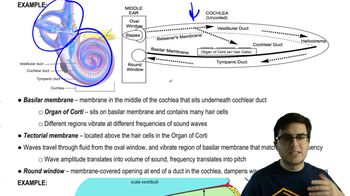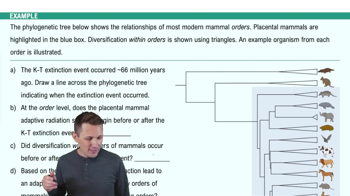Table of contents
- 1. Introduction to Biology2h 42m
- 2. Chemistry3h 40m
- 3. Water1h 26m
- 4. Biomolecules2h 23m
- 5. Cell Components2h 26m
- 6. The Membrane2h 31m
- 7. Energy and Metabolism2h 0m
- 8. Respiration2h 40m
- 9. Photosynthesis2h 49m
- 10. Cell Signaling59m
- 11. Cell Division2h 47m
- 12. Meiosis2h 0m
- 13. Mendelian Genetics4h 44m
- Introduction to Mendel's Experiments7m
- Genotype vs. Phenotype17m
- Punnett Squares13m
- Mendel's Experiments26m
- Mendel's Laws18m
- Monohybrid Crosses19m
- Test Crosses14m
- Dihybrid Crosses20m
- Punnett Square Probability26m
- Incomplete Dominance vs. Codominance20m
- Epistasis7m
- Non-Mendelian Genetics12m
- Pedigrees6m
- Autosomal Inheritance21m
- Sex-Linked Inheritance43m
- X-Inactivation9m
- 14. DNA Synthesis2h 27m
- 15. Gene Expression3h 20m
- 16. Regulation of Expression3h 31m
- Introduction to Regulation of Gene Expression13m
- Prokaryotic Gene Regulation via Operons27m
- The Lac Operon21m
- Glucose's Impact on Lac Operon25m
- The Trp Operon20m
- Review of the Lac Operon & Trp Operon11m
- Introduction to Eukaryotic Gene Regulation9m
- Eukaryotic Chromatin Modifications16m
- Eukaryotic Transcriptional Control22m
- Eukaryotic Post-Transcriptional Regulation28m
- Eukaryotic Post-Translational Regulation13m
- 17. Viruses37m
- 18. Biotechnology2h 58m
- 19. Genomics17m
- 20. Development1h 5m
- 21. Evolution3h 1m
- 22. Evolution of Populations3h 52m
- 23. Speciation1h 37m
- 24. History of Life on Earth2h 6m
- 25. Phylogeny2h 31m
- 26. Prokaryotes4h 59m
- 27. Protists1h 12m
- 28. Plants1h 22m
- 29. Fungi36m
- 30. Overview of Animals34m
- 31. Invertebrates1h 2m
- 32. Vertebrates50m
- 33. Plant Anatomy1h 3m
- 34. Vascular Plant Transport1h 2m
- 35. Soil37m
- 36. Plant Reproduction47m
- 37. Plant Sensation and Response1h 9m
- 38. Animal Form and Function1h 19m
- 39. Digestive System1h 10m
- 40. Circulatory System1h 57m
- 41. Immune System1h 12m
- 42. Osmoregulation and Excretion50m
- 43. Endocrine System1h 4m
- 44. Animal Reproduction1h 2m
- 45. Nervous System1h 55m
- 46. Sensory Systems46m
- 47. Muscle Systems23m
- 48. Ecology3h 11m
- Introduction to Ecology20m
- Biogeography14m
- Earth's Climate Patterns50m
- Introduction to Terrestrial Biomes10m
- Terrestrial Biomes: Near Equator13m
- Terrestrial Biomes: Temperate Regions10m
- Terrestrial Biomes: Northern Regions15m
- Introduction to Aquatic Biomes27m
- Freshwater Aquatic Biomes14m
- Marine Aquatic Biomes13m
- 49. Animal Behavior28m
- 50. Population Ecology3h 41m
- Introduction to Population Ecology28m
- Population Sampling Methods23m
- Life History12m
- Population Demography17m
- Factors Limiting Population Growth14m
- Introduction to Population Growth Models22m
- Linear Population Growth6m
- Exponential Population Growth29m
- Logistic Population Growth32m
- r/K Selection10m
- The Human Population22m
- 51. Community Ecology2h 46m
- Introduction to Community Ecology2m
- Introduction to Community Interactions9m
- Community Interactions: Competition (-/-)38m
- Community Interactions: Exploitation (+/-)23m
- Community Interactions: Mutualism (+/+) & Commensalism (+/0)9m
- Community Structure35m
- Community Dynamics26m
- Geographic Impact on Communities21m
- 52. Ecosystems2h 36m
- 53. Conservation Biology24m
32. Vertebrates
Chordates
Problem 13c`
Textbook Question
The size and shape of the vertebrate skull can reveal a great deal about an animal's lifestyle and evolutionary relationships. Consider your own skull. If you put your finger in your ear and move your jaw up and down, you can feel the space near the hinge of your jaw. Nestled in this space are the tiny bones that make your hearing possible: the malleus, incus, and stapes. All mammals have these three ear bones, but reptiles such as this T. rex don't. Where did ear bones come from? The illustration of the opossum skull shows that the ear bones are completely separated from the jawbone (as they are in all mammals).
Pose a hypothesis to explain why this separation could be an adaptation that contributed to the radiation of mammals into diverse niches, including a nocturnal lifestyle.
 Verified step by step guidance
Verified step by step guidance1
Understand the evolutionary context: Mammals evolved from reptilian ancestors, and during this process, certain structures in the skull underwent significant changes.
Identify the structures involved: In mammals, the malleus, incus, and stapes are the three tiny bones in the middle ear that are crucial for hearing. These bones evolved from jawbones present in reptilian ancestors.
Consider the functional advantage: The separation of ear bones from the jawbone in mammals allows for more specialized and sensitive hearing. This adaptation could be particularly advantageous for detecting high-frequency sounds, which is important for nocturnal animals that rely on sound rather than sight.
Hypothesize the adaptive significance: Propose that the separation of ear bones from the jawbone allowed mammals to exploit a wider range of ecological niches, including nocturnal environments, by enhancing their auditory capabilities.
Connect to mammalian radiation: Suggest that this auditory adaptation may have contributed to the successful radiation of mammals into diverse ecological niches, as it provided a competitive advantage in environments where keen hearing is beneficial.
 Verified video answer for a similar problem:
Verified video answer for a similar problem:This video solution was recommended by our tutors as helpful for the problem above
Video duration:
2mPlay a video:
Was this helpful?
Key Concepts
Here are the essential concepts you must grasp in order to answer the question correctly.
Evolutionary Adaptation
Evolutionary adaptation refers to the process by which organisms adjust to their environment over generations, enhancing their survival and reproduction. In the context of mammals, the separation of ear bones from the jawbone may have evolved to improve hearing capabilities, aiding in the exploitation of diverse ecological niches, including nocturnal environments.
Recommended video:

Adaptive Radiation
Mammalian Ear Structure
Mammals possess three distinct ear bones: the malleus, incus, and stapes, which are crucial for transmitting sound vibrations to the inner ear. This unique structure allows for more sensitive hearing compared to other vertebrates, such as reptiles, and is a key adaptation that may have facilitated the diversification of mammals into various ecological roles.
Recommended video:
Guided course

Inner Ear
Radiation of Mammals
The radiation of mammals refers to the evolutionary process where mammals diversified into a wide range of forms and ecological niches. This diversification was likely aided by adaptations such as enhanced auditory capabilities, allowing mammals to thrive in different environments, including nocturnal settings, by improving their ability to detect predators and prey.
Recommended video:

Adaptive Radiation Example 1
Related Videos
Related Practice




























